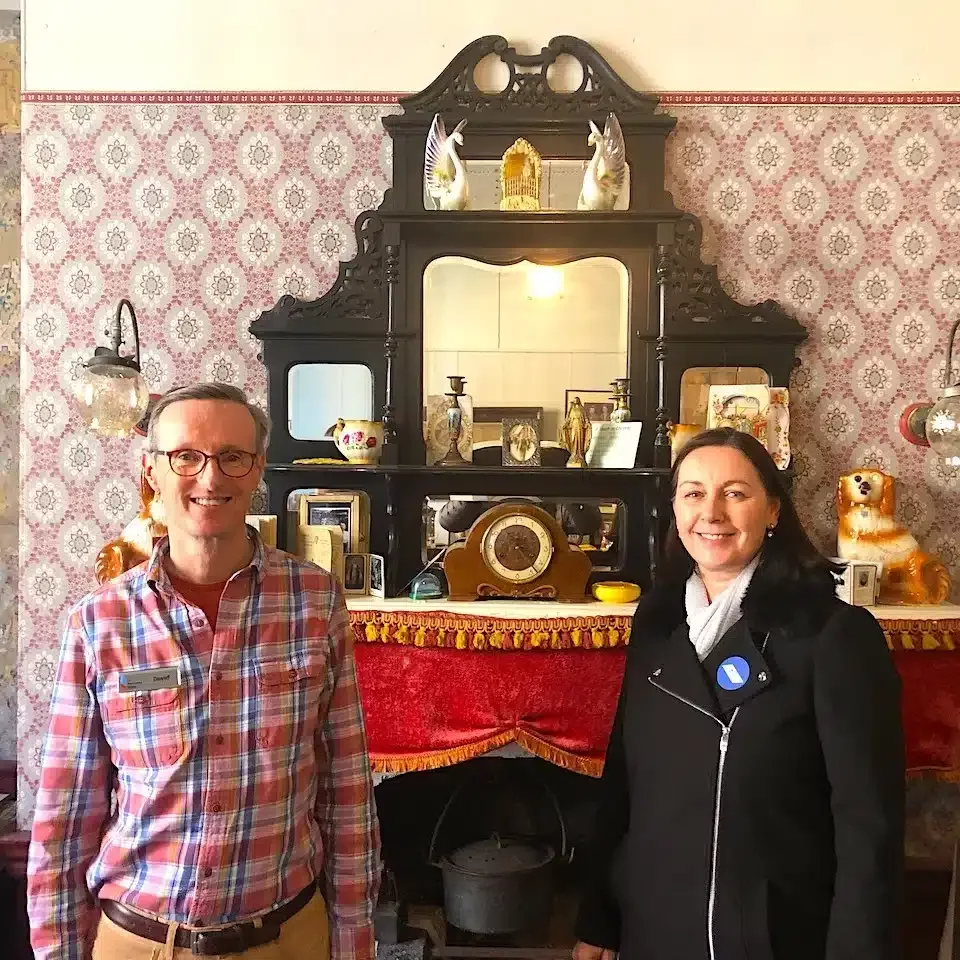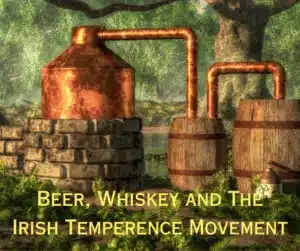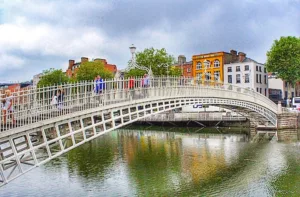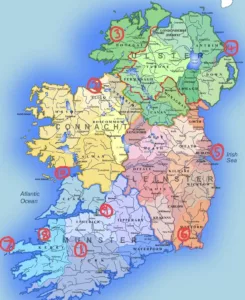A Tale of Two Cities – The Tenement Museums of Dublin and New York (#408)
In the late 1800s, hundreds of thousands of Irish people moved into the Tenement Buildings of Dublin and New York. In this Podcast, we travel to the Tenement Museums of both Dublin and New York to get an insight into what life was like in these buildings for our Irish ancestors.

You can listen to the show on your computer/smartphone by clicking on the play button above (the triangle with the circle around it). You can also download the show onto your computer by clicking on the download symbol. Enjoy!
Episode Summary:
Welcome to Season 4, Episode 8 of the Letter from Ireland Show.
In this episode of the Letter from Ireland Show we travel to two very unique museums – each on the opposite side of the Atlantic ocean! First we pay a visit to the Tenement Museum in lower Manhattan – and then we go to the newly-opened Dublin Tenement Museum called 14 Henrietta Street. As well as enjoying the spoken word above – you can view the entire transcript below.
The Letter from Ireland Show is a weekly podcast that goes out each Thursday from our cottage in County Cork. Tune in to this episode – and dive straight in to a bit of Irish caint, ceóil agus craic (conversation, music and craic!).
Transcript.
Carina: Hello, and welcome to The Letter from Ireland show, series four, episode eight. We hope you’re well wherever you are in the world today. Céad Míle Fáilte, which means you’re very welcome, and it’s great to have you with us.
Mike and I are both Irish, and live County Cork in the south of Ireland. From here we write a weekly Letter From Ireland, and we also run the Green Room, an active membership community helping those searching for their Irish ancestors.
Now, The Letter From Ireland has been going out to thousands of readers over the last five years, and as you can imagine, there’s a lot of correspondence back and forth between ourselves and the readers of the letter.
Now, many of the readers in The Letter share their Irish family history with us. And one question that’s often asked is what living conditions were like for their families in Ireland, and maybe what it was like for them in the early days of their emigration to a new country.
To answer these questions, in today’s show we are off to visit two tenement houses. One here in Ireland in Dublin at 14 Henrietta Street, and the other tenement house across the water in 97 Orchard Street, lower east side of New York City.
What was a tenement house, you might ask? Well, as we discovered doing the show, a tenement house is a large house where the rooms are divided into several small partitioned off apartments. This is to provide accommodation for many families, who then live in very close proximity. And of course, this often led to dire health and sanitation problems. Mostly the poor ended up living in these very cramped conditions in tenement houses.
The tenement houses we visit for the show, at 14 Henrietta Street in Dublin, and the tenement museum at 97 Orchard Street in the lower east of New York City, these were both classed as tenement houses, but had very different beginnings, and I’ll explain more.
The Irish house on Henrietta Street in Dublin had been inhabited, and was inhabited, for over 300 years. But, it did not begin life as a tenement house. Quite the opposite in fact. It had aristocratic beginnings as a grand townhouse built in 1748, for the Right Honourable Richard Lord Viscount Molesworth and his wife Mary Jenny Usher. And this then was turned into tenements in the 1870’s, and remained like that until the last family left as late as the 1970’s.
Over in New York, the New York tenement house was purpose-built for a large number of families right from the beginning, and it was subdivided into small apartments to enable many families to live together in their own separate apartments, but sharing facilities with one outside water tap and a few outside toilets.
Many of our ancestors, as you know, travelled to America, and arrived in great numbers from the mid-1800’s. And many of them arrived into the port of New York. This was a major port for emigrants, and significant numbers stayed on in New York.
One of these families was Joseph and Bridget Moore. Now, we’re going to discover a bit more about them today. They arrived here after the family in Ireland in the 1860’s. I’m sure many of your ancestors did, too. And they lived for a while at Five Points. Five Points was a very bad slum area in Manhattan. No clean water or sanitation at all. So that led, inevitably, to very high mortality rate for infants. And so, the Moore family, in order to better their lives and their children’s health, moved from Five Points to the tenement house that we went to visit at 97 Orchard Street in lower east side New York City.
THE FOLLOWING WAS RECORDED OUTSIDE THE TENEMENT MUSEUM IN NEW YORK CITY:
Carina: So, this is 97 Orchard Street in Lower Manhattan, in New York City, and we’ve come here because it’s the site of the tenement museum.
This whole area in the 1850’s, New York City had an influx of people, migrants, coming here to live in the city. And that gave rise to the growth of tenements, which were buildings really, cheap accommodation for people, where they were piled in maybe … I believe in the tenement museum here there were 22 families, with two storefronts at the front. And really, people were crowded in here with very low facilities available to them.
We are very interested to go in there to follow the family there. Ruth Abram actually started this house here, the tenement house, when she discovered it was derelict for 50 years. She saw that there was an opportunity to show what immigrants have brought here to New York City and to America, and to show and tell their stories. So, we’re going in to follow the story of an Irish family in there.
The tour is starting in a minute. I can’t take in cameras, but we’ll keep you updated and we’ll talk about it later on. So, we’re really looking forward to that tour.
After the tour and standing at the busy Manhattan street outside the tenement museum, I share some thoughts of what it felt like stepping back in time and walking through the house and experiencing what life was like for the tenants, and especially that one family from Ireland, the Moore family.
Carina: Well, Mike and I have had a most interesting experience in the tenement museum behind us. The tenement house was occupied for something like 70 years, and 7000 families moved through it. But the family that we were interested in lived there in 1867, and they were the Moore’s, Bridget and Joseph Moore. They both came from Ireland, and because they came around that time, they were actually born during the famine years in the 40’s. So, they were children of the Irish Famine, coming here to America and living here.
When they were married, they were at Five Points, which is a very poor district south-west of here. And we realized that this tenement, even though at the time … To us now it might look small and cramped, it was actually quite luxurious to that Irish family, because number one, they had running clean water from the aqueduct, and they also had toilets that were connected to the city sewers. So, they moved from Five Points where none of those facilities were, because one of their children was very poorly … unfortunately that child, Agnes, died here, and they moved on again after a year.
In the house itself, it was I suppose very much like traveling back into a little home in Ireland really. There was the usual things. The cross, the shamrock, the musical instruments, and all the little things that would remind me really of what Ireland was like.
So, Bridget created here for her family a little oasis I think in the house because she was only one of two families living there. They were Irish Catholic, whereas the majority of them were Protestant and German-speaking. So, in a way, inside in her apartment was her home with her family.
And a very nice ending to the story was that her own family have continued to … her children, while four of them first lived, then their children all of their children have lived, their grandchildren, and there’s still some of them living around here in the area, and they came back to visit the tenement museum not so long ago.
So, there you go. Another family, another life, and new opportunities for people. And as the director, I think, of the building mentioned this was a building for hope, where people came for new dreams in a new world. And America provided that for them.
Census records and employment records filled in the details of the Moore family for us. And history of course tells us too that the Irish over the next two generations began to prosper in America, and went on to rise up through the ranks of society. A major part in this progress was the fact that they could vote while others could not.
Mike and I experienced the pride the city takes in honouring its Irish past, especially on St. Patrick’s Day. And that was the weekend we happened to be there. And green is then proudly worn, and the impressive skyscrapers are green just for that night.
Carina: When we got back to Ireland, we knew we had to visit the tenement museum in Dublin, so as part of our tour there on Henrietta Street, which by the way is only a few minute’s walk up from the main street in Dublin, which is O’Connell Street. And when we got to Henrietta Street, we spoke to David, our guide for the tour that day.
Here, David gives us a history of the times and the house on Henrietta Street.
THE FOLLOWING TAKES PLACE IN THE TENEMENT MUSEUM (14 HENRIETTA STREET) IN DUBLIN):
Carina: David, we’re here at 14 Henrietta Street, and this is a very unusual building. Can you give us a little bit about the history before we take a tour around?
David: I’d be happy to, and we’re on Dublin’s areas Georgian Street. So, although it’s quite a broad street, it’s a very short street. Developed initially in the 1720’s, and this house dates from 1748. So, it’s one of the last houses on this street to be built.
Only 15 houses on the street, and was developed by a man called Luke Gardiner, who was a property tycoon in his day, a member of Parliament, and a private banker. And he lived on this street himself in the 1720’s and 30’s, and he wanted to have the ruling elite as neighbours, so he built it with that in mind.
Carina: So, this was a very classy street back in the day.
David: This was the classiest street in Dublin during its hay day. Yes, absolutely.
Carina: Oh great. But things changed. The Act of Union, I believe, brought change in politics and change in this scene here at this house.
David: It did. It brought huge changes to this street, to Dublin generally, and specifically this house as well. And the ruling elite all vanished really. Many moved to Dublin, because Parliament ceased to take place in Dublin.
Carina: So, they moved from Dublin, off to London, after 1801.
David: Exactly. Yes. Yes.
David: And what filled the vacuum was the legal profession, because during the early 1800’s the King’s Ends, which is at the end of this street, is that large cobblestone building for the training of barristers was developed. So, in effect, Henrietta Street becomes a legal enclave, and aristocrats replaced by legal professionals.
Carina: And from the outside of the house, is a Georgian-type house. You’ve got the archetrave over the … What is it? The half circular window over the door-
David: Yes.
Carina: And you’ve got a red brick. How many stories is the house?
David: It’s massive. The houses here are considerable in scale compared with other Georgian buildings. It’s four stories over basement, with particularly high ceilings, and it’s four bays wide. So, in the Georgian context, it’s a much bigger house than most of the houses you might get on Merrion Square, or if it’s William’s Square, and so on.
Carina: Now, the interesting thing you were saying earlier as well is that the houses, the tenement houses, because that’s the next phase that the house goes into, and that’s the history that we’d love to hear you chat about as well today, is that this house really wasn’t a tenement house to begin. It had that grand history, aristocracy living in here, but then things changed, as opposed to maybe other tenement places.
David: Exactly.
David: The initial original family that lived here were the Molesworth’s, Viscount Richard Lord Molesworth and his wife Lady Mary, and they were followed by a succession of titled people, Baronets and Viscounts. So for the first 50 years or so, it was the ruling elite of Irish society who lived on this street and in this house. And then as we were saying, things begin to change with Act of Union quite dramatically, legal professionals move in.
David: And then there’s one or two kind of curious incarnations as a courthouse, post-famine era, then to dealing with all the large indebted estates, and then it becomes for a relatively short period an army barracks. That’s quite a radical change of fortune for an aristocratic house, and that’s the first instance of it becoming a multi-family house.
Carina: Yeah, the multi-family thing. That was quite fascinating when you were speaking about that. How many people then, as you say, is … I let it over to you. So, what happened next in the house?
David: Okay. Well, the Dublin military are expelled by the legal professionals on the street. They petitioned to have them expelled versus asking them out of respect.
David: And that brings us to 1877, when a Dublin businessman called Thomas Vance buys number 14. He’s multiple business interests. He’s not really a career landlord like a lot of the others, and he systematically subdivides the house into 17 flats. He removes the magnificent marble fireplaces, as we only know of them by description now, and he inserts a range and an oven in each of the fireplaces, and creates 17 discreet flats.
David: We understand that he was probably offering well-meaning decent accommodation to lower-income families at that point.
Carina: And of course, there would have been a lot of lower-income families. If you’re talking about the 1870’s, we’ve passed through the famine era-
David: Exactly.
Carina: And quite a lot of numbers of people leaving the land and emigrating.
David: Exactly.
Carina: But also, coming to live in the capital city.
David: That’s it. Dublin, in terms of population, is exploding to some degree because of the displaced people from lower Ireland. And like you said, many obviously emigrate or they die of starvation.
David: But Dublin begins to expand, and Thomas Vance and other landlords are trying to maybe meet that need, and obviously, they have profit in mind as well.
Carina: And by the 1901 Census, how many families are living in 14 Henrietta Street?
David: The 1901 Census tells us that there were 17 families, and that there were 87 people living in this house. And we know that there was just the one indoor toilet off one of the landings, and then there were two additional toilets in a lean-to accessed out the back. There wasn’t plumbing in any of the flats. In fact, there never was. And people either had access to a cold water tap in the basement, or a cold water tap out in the backyard.
Carina: And the distinctive colour along the hallways as well you were explaining a little bit. Can you tell us a little about that red and blue?
David: Yes. Well, they have particular names, and those colours are called Reckitt’s Blue and Red Raddle, and they’re synonymous with Dublin tenements. So, we find when people come on tours who have a tenement background themselves, you can see them smiling and recognizing the names and responding to the colours.
Carina: That’s interesting isn’t it that in Dublin here you get a lot people maybe … It’s not that long ago. People were living here then up until, you said, 19 …
David: Late 1970’s. And we quite regularly get people on tours who have a strong tenement background themselves, or who have even been born in this house.
Carina: Now, we’re standing in one of the tenement’s dwellings, which of course is a subdivision of. So this room is towards the front of the house. Are we on the first floor?
David: We are on the ground floor now. So, we’re on what would have been one of the family parlours in the Georgian period, and it’s accessed just out from the main ground stairway.
Carina: So, let’s go and talk about the family maybe that lived in this house here as we walk around and look at it.
David: Sure. Yeah.
Carina: It was truly fascinating walking through the house. And then David told us about the Dowling’s, who lived in one room in this huge house. The room was partitioned into three areas. One area was a whole kitchen, the other was the sitting area, and the third area was the bedroom. Now, it was very well furnished, and it looked as if the Dowling’s had just popped out the door for a few minutes.
Carina: So, David, one family lived in this particular room here on the ground floor.
David: Mm-hmm (affirmative)-
Carina: Can you tell us a little bit about this room and the family that lived here?
David: Absolutely. Well, their name was the Dowling’s. They moved in in the 1940’s. The parents were George and Elizabeth, and they had three children. So, by tenement standards they had quite a small family … surviving family that is.
Carina: Surviving, you mean the operative word there?
David: Yeah. Well, we understand that Elizabeth had quite a few pregnancies, but only three surviving children.
Carina: So, this room here that we’ve just walked into is their reception hallway, kitchen-
David: Yeah, it’s kind of all of that. I mean you’ll see straight away that partitions are in place, and these were a feature of all the flats, these relatively low-level partitions, and people came straight into the kitchen area.
There is the gas cooker behind me here. Gas came into most of the flats in the 1920’s. We’ve got the gas meter as well.
Carina: But no sink.
David: No sink. Yeah, people look and they see a cooker, presses, and products and think, “Oh. This is quite a well-equipped space.” But when you look for a sink there’s no sink, because plumbing never came in.
So even in the late 1970’s the residents were relying on one very unreliable indoor toilet. We know that water pressure was really bad, it took the whole night for the cistern to fill up. And of course for cooking and for bathing there was no facilities at all. So, the people used to go outside to the good water tap, bring up buckets of water, boil the water, and then of course dispose with it afterwards.
So quite a degree of hardship beyond what might … One gets the sense straight away.
Carina: So why don’t we have a look in here? This is their main kitchen, dining. I see a [crosstalk] on the side.
David: Yeah, so the family like I said were George and Elizabeth. George the father contracted tuberculosis, a big killer, in inner city Dublin. He died very young. And after he died, Lily his daughter shared the bed in the designated bedroom area with her mother Elizabeth, and we’ll go in there in a minute. And then there were the two boys, and they slept top to tale in the bed here. You’ll notice our new jacket on the bed, so-
Carina: Is that instead of a blanket?
David: Instead of a blanket, yeah. Blankets were often in short supply, and coats being made of wool, very warm.
Carina: And I see their drying system there is-
David: Yeah, including the outhouse of course. What you see here is kind of life as it was from the 1940’s right up until when they left in the late 1970’s.
Carina: So, the Dowling’s lived here until the 1970’s?
David: They did, yeah. Yeah. And then Lily, the daughter, is still alive. She’s in her mid-90’s now, and it’s her grandchildren who have donated pretty much everything that you see here. So, the flat has been recreated based on their memory, their photographs, and using their furniture and their photographs.
Carina: Really lovely! Really lovely.
David: It is.
Carina: And I see the little baby bassinet here over by the window. I’m sure children must have been a feature of Henrietta Street.
David: Oh, they were. Well, we know hundreds of babies were born in this house.
And I guess also, we need to be cognizant of the fact that there was a very high infant mortality rate as well during the late 1900’s era, 20th century. One third of children didn’t see their fifth birthday.
Carina: Wow.
David: That we know of-
Carina: Shocking number.
David: Absolutely. And there was one family who lived just opposite us, a Catherine Davis. She and her husband had 14 children, only 12 survived.
Carina: Two-
David: 12 out of 14 died before reaching adulthood.
Carina: 12 out of 14?
David: Yeah.
Carina: So, two just survived.
David: Yes.
Carina: Wow. That’s really shocking. And also, I think the number of people in the early 1900’s that lived in tenements like this, that was quite a high population too, wasn’t it here in Dublin?
David: Huge population. Even on this street. It’s a short street, a broad street, 15 houses. At its peak, there were 1000 people living on this street. So, it’s just like a village, even though it was a single short cul-de-sac.
Carina: In crowded conditions and poor sanitation-
David: They were crawling in conditions, yeah.
Carina: And poor health.
David: Yup.
Carina: And as you said, even the person here, Mr Dowling that died of TB. So, when we have a look in their bedroom, again partitioned off and they are-
David: Yeah, partitioned off and both Elizabeth, the mother, and Lily, her daughter, were accomplished dressmakers or seamstresses. So, you can see a Singer sewing machine and dressmaking equipment and so on.
Carina: So, I guess when the father of the family died that they had to fend for themselves. So, a seamstress would have been a good occupation I guess.
David: Yes. I think that may have been brought in some money, but both of them worked in a factory. The same factory, the Player Wills factory on the South Circular Road. And that’s where Lily, now in her mid-90’s, that’s where she met her husband Mr. Butterworth. So, both mother and daughter had a strong connection with this particular factory.
Carina: And the Players are, of course, cigarettes. Isn’t that right?
David: Exactly. Yes, indeed. Yes.
Carina: Cigarettes. So, having a quick look around at the bedroom, so you’ve got the metal bed.
David: Yes. Again, a rather sort of posher version than what one might have seen in the peak tenement period, because of the brass fitting that is on it. But metal beds were the norm, and even during the tenement period, if people had a bed, it was usually a metal bed.
David: Of course, what was happening is that huge numbers of people were sharing the same bed. And the flat we visited earlier in the basement, we know that there were 11 children, two parents, and they only had two beds between them.
Carina: Well that flat in the basement gave me shivers. I must say it’s really, really horrific. You said that was 14 feet really underground. Very cold, very damp.
Carina: And one of the stories I think that you mentioned was that one of the boys who lived in a flat next door here-
David: Yes.
Carina: His mom said he survived because he was born in the summer.
David: Yes. The family moved to just the other side of this wall, but he-
Carina: What were their surnames again, David?
David: Their surname was Brannigan. And they were born … or Peter Brannigan, who’s now 79, he was born in that basement flat. And like I was saying, his mother told him years later that she felt the only reason he survived was because he was born during the summer and not the winter, because the conditions were so appalling. It was like being in a cave.
Carina: Well David, thank you very, very, very much for bringing us around the Dowling’s house here. And they then moved on and left and moved out of the city, and were moved to houses that were built … It was quite later. It was 60, 70’s wasn’t it, in the 70’s I think-
David: They left-
Carina: The last people moved out in 1979.
David: Yeah. Exactly. Yes.
Carina: Nice. Well it’s a wonderful project you have here, David. And thank you very much for taking us around.
David: My pleasure.
Carina: I’m sure we’ll have a lot of people come to visit 14 Henrietta Street and see really what life was like in Dublin in the 1900’s. Thanks, David.
David: Thank you very much.
Carina: One thing is certain listeners. After our visit that day to the tenement house, I don’t think I will ever again take for granted the advantages of plumbing and warmth in my own cosy home.
When we were speaking to David, the differences and similarities of both tenement houses here in Dublin and in New York struck me. While both houses were rescued for the public to visit, the New York house was saved from demolition way back in 1988 by Ruth Abraham, and has been running tours for many years now. And in Dublin, 14 Henrietta Street is a relatively new arrival on the scene. And with the help of the Dublin locals and the Dublin city council, it’s just really been restored recently and open to the public.
The houses differed in that the Dublin tenement house had been adapted as the fortunes of Dublin changed, and went from the grand house for one family to housing 17 families. The New York house was purpose-built for many families in needing cheap accommodation.
The Irish families that lived in Dublin were among their own people and had the comfort of neighbours that spoke their language, and shared their Catholic religion and traditions, while the Moore’s were outsiders in their home in the New York tenement. Away from Ireland, and being only one of two Irish families among 22 families in the building. And bear in mind too the majority of their neighbours were Protestant and German-speaking, with a very different culture, customs, and outlook.
Carina: Visiting both houses in different parts of the world gave us a glimpse into the lives of our ancestors. Those that had said in Ireland, flooding into the crowded city of Dublin after the famine, and those that had decided to take the boat and a chance on a better life in a new world in America.
Did you enjoy our visits to the tenement houses? Well I certainly did, and we’re very grateful and a big thanks to David for sharing his time so generously with us when we visited 14 Henrietta Street in Dublin.
I feel it’s always a privilege to experience and learn about the conditions our ancestors faced, whether they were here in Ireland or on the journey to a better life somewhere else for the families.
I hope it answered some of the queries to those of you listening, who’s families may have passed through houses very similar to the tenement houses that we visited. If so, do take the opportunity to visit Henrietta Street.
Once again, it’s time to say Slán, and a warm thanks for you listening today. Thank you very much, and thanks to our friends in the Green Room and to the readers in the Letter From Ireland, who’s queries prompt a lot of our answers here in our show.
If you’re wondering about your Irish ancestors and you’d like to check maybe the links from today’s show, just go to the show notes at aletterfromireland.com/408.
So, bye for now. Thanks for listening, and we look forward to you joining us again next time on The Letter From Ireland show. Remember, Tóg go bog, take it easy.
Related Articles and Links
- Not a member of The Green Room yet? You can see more about The Green Room here.
- The latest issue of the Letter from Ireland Magazine is available here.
- “A Letter from Ireland: Volume 3” – is available from Amazon.com here OR Amazon.ca here OR Amazon.co.uk here OR Amazon.com.au here.
- See All Current Available Episodes of the Letter from Ireland Show.
Thank You For Listening
We really appreciate you choosing to listen to us and for supporting the podcast. If you enjoyed today’s show, please share it using the social media buttons on this page.
We would also be eternally grateful if you would consider taking a minute or two to leave an honest review and rating for the show in iTunes. They’re extremely helpful when it comes to reaching our audience and we read each and every one personally!
Finally, don’t forget to subscribe to the podcast in iTunes to make sure that you never miss an episode. Do feel free to leave a comment or question in the section below. We’d love to hear from you!
Slán for now, Mike and Carina.







Only Plus Members can comment - Join Now
If you already have an account sign in here.